Going camping can be fun for everyone involved, but if you’re not fond of “living off the land”, then you’re going to need to prepare a camping food list to take with you that will not only keep everyone else happy, but will also provide the nutrition that you’ll need to stay healthy.
[the_ad_placement id=”in-text-1-type-r”]After all, you’re going to be burning a lot of calories having to set up camp, as well as hiking all that distance from your car. A lot of people rely on only trail mix, but this only serves as one part of the food list that you should bring with you, especially if you’re going to be camping for a few days.
Variety is the spice of life, and having different foods with you can make the experience much more enjoyable. On the same note, you also don’t want to bring your whole fridge with you, so it pays to know what foods to bring that aren’t going to overburden you in terms of weight.
Planning your meals
When determining how much and the kinds of food you want to bring with you, it’s important that you first ask yourself some very important questions:
- how much cooking you plan or intend to do during your camping trip?
- are your cooking options limited by the campsite area or park you’ll be in?
- how much time is being allotted to eating and cooking?
- are meals going to form a big part of your trip or are they going to be interspersed between other rigorous activities?
- what is the average age group that you’ll be cooking for?
- what is your chosen method of cooking? Campfire? Grill? Stove? Or a combination?
- what kind of cookware will you have at your disposal?
Answering these questions will help you plan what food you should bring. For example, you shouldn’t pack food that will take a long time to prepare if your camping trip is going to involve a lot of activities that are timely in nature. Also certain foods are easier to cook over campfires than others, so it would be a waste of food to be ill-prepared.
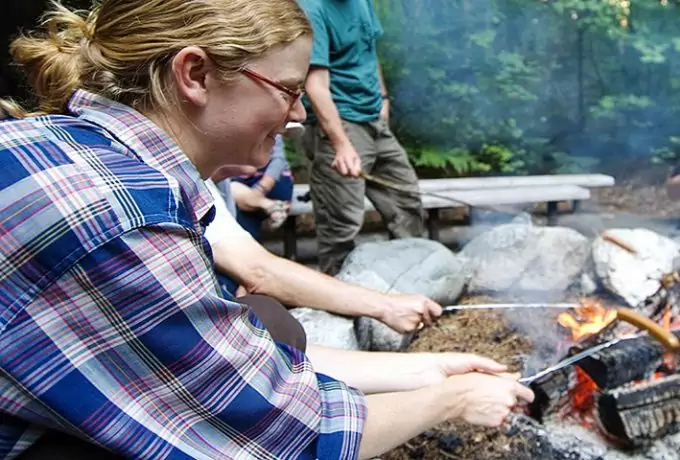
When planning your meals, you should take into account the meals you’ll have on arrival and departure days, breakfast, lunch and dinner for each of the days that you’ll be camping, snacks and fruit to snack on between meals, and beverages to keep you hydrated and energized.
Planning for arrival day
Arriving at the campsite can be hectic in and of itself, so you shouldn’t plan for a big, exorbitant meal to start off your trip. You’ll be too tired from lifting all the equipment from your car, setting up your tent, and ensuring that you have everything in place. Something that’s simple and quick to fix is the best option for you. If you like, you can always prepare the meal at home first and then just heat it up at the campsite when you get there to save you a lot of time and energy.
First meals of the day
Breakfast is always a good way to start the day, and will get you jumpstarted for the challenges and chores that you’ll have ahead of you. How you choose to start is up to you and your unique tastes, as well as those of the people you’re camping with. If you want a hearty breakfast, you can create a breakfast meal that involves bacon or sausage, eggs, hash browns, pancakes, pre-baked toast or biscuits, and coffee or juice. This will keep you warm and full for a long time, and the protein will keep you fueled for a good while as you go about the rest of your day.
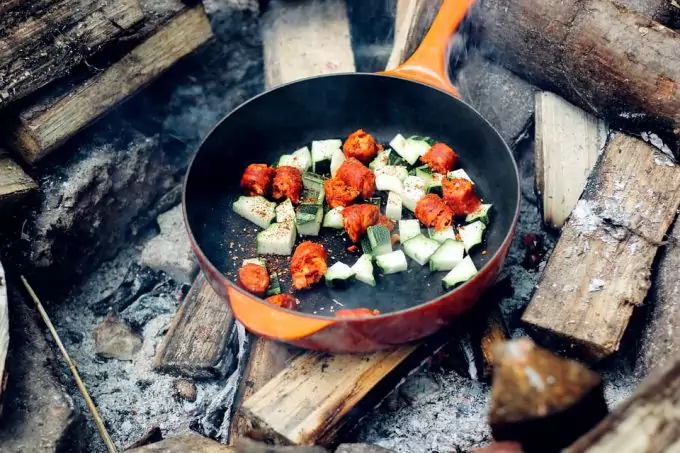
If you’re looking for a lighter breakfast, then you may prefer a meal consisting of bagels with spread, instant oatmeal, cold cereal with milk, fruit, and juice. Light meals are best suited for when you wake up extremely early in the morning and need that little pick-me-up. Hearty meals this early can sometimes lead to indigestion, especially if you’re not used to waking up at such times.
Other items that you can include to add some variety to your breakfast meals are:
- jam
- yogurt
- tea (hot or iced)
- granola bars
- canned fruit
- any berries you may find on the grounds that you’re familiar with
- any meat you hunt
Eating the same thing every day will definitely not keep spirits up, and can even start to demoralize those around you. But remember, you are limited by what you can carry with you, so you shouldn’t have to prepare five-star meals from an expensive restaurant.
Get more options by reading our article on delicious and easy to prepare breakfast meals – check it out!
Lunches
Lunches should always be light, since they’re in the middle of the day and you don’t want to suffer from the groggy effects of greasy and fattening food. Lunch is meant to keep you going, especially in the middle of the day when the sun is the hottest and brightest and you don’t want to get burned.
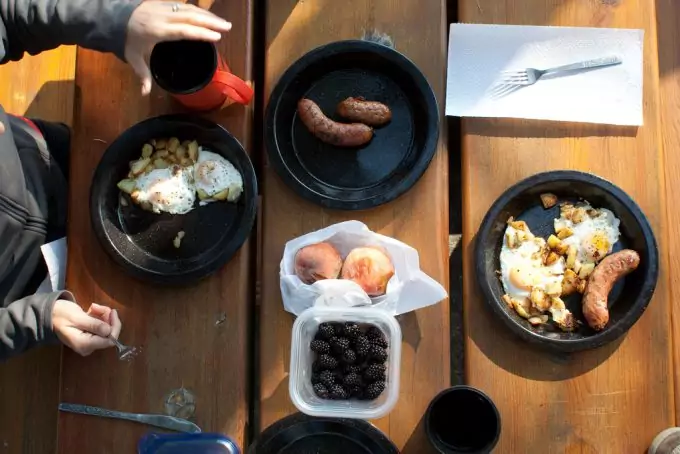
Whether you’re choosing to hike, kayak down a river, or just sit around and take in the scenery, having a fast and quick meal to eat will keep your energy levels up. Some examples of good light lunches are sandwiches made with cold cuts or PBJ, a bag of potato chips, pasta or potato salad, a piece of fruit, and a drink, either water or juice.
See: Hiking Food: Best Lightweight, Tasty and High Energy Options
Having portable spreads can also make the difference in your sandwiches, such as ketchup, mustard, mayonnaise, and butter. Pickles and relish can also add a bit of spice to your meals and raise your spirits in the middle of the day. Instead of cold cuts, bring cans of tuna that are easy to carry and provide a good source of non-fatty protein. Havarti cheese can be kept in your cooler and won’t go bad over time, allowing you to have a bit more flavor with your sandwiches.
Dinners
Dinner can be the best time to be elaborate with your meals and go all out. With the roar of the campfire and everyone gathered around it, creating a filling and hot dinner will prepare everyone for the quiet and chill night that’s to follow. See our article on nutritious and easy campfire food recipes that don’t require much effort to prepare.
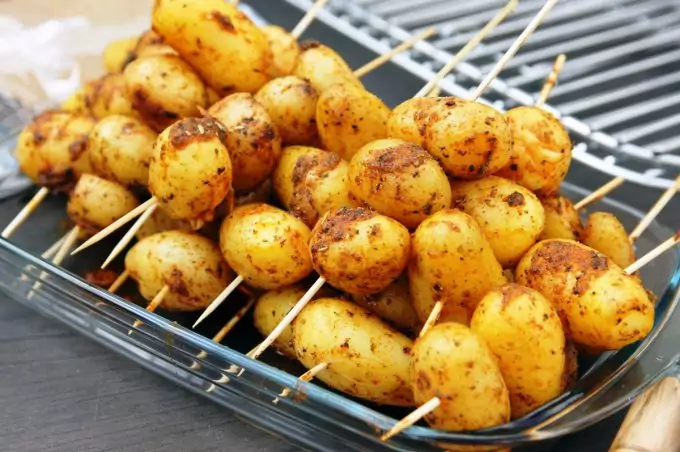
A hearty dinner should include meat, potato and a vegetable (this can be separate or cooked as a one-pot skillet meal), biscuits or rolls, and coffee and drink. Having a dutch oven at your disposal will definitely make cooking dinner a lot easier, especially if you have no problem making a stew. A lighter dinner can consist of hotdogs and/or burgers (depending on the cooking regulations in the area), macaroni and cheese, meals that can be cooked in tin foil, soup and sandwiches, and a beverage.
[the_ad_placement id=”in-text-2-type-r”]To add some variety, you can also include:
- boneless steaks (they cook more evenly)
- bratwurst sausages
- pre-cooked rice (can also be used in stews to make them thicker)
- quinoa
- tortillas (leftover food from previous meals can be incorporated so no food is wasted)
- canned beans
- canned tomatoes
- salsa
- corn on the cob (are easy to cook in tin foil)
Desserts
Nothing’s better to keep you going than a sweet treat at the end of the day. We’re not talking about anything as heavy as cake or ice cream sundaes, and although you may miss them, every little bit helps in making your experience as enjoyable as possible. Of course, the most common dessert for any campfire is Smores.

Image credit: orage.com
It’s easy to make and doesn’t take a lot of space in your bags for transportation. Graham crackers, chocolate bars and marshmallows are all you need to make this tasty and messy treat, but be sure to clean up the bags and containers that you brought these in, as the sweet smell is enough to attract bears and ants to your campsite, and that can ruin your experience.
Another easy and simple dessert to make is a chocolate banana boat; simply melt a chocolate bar with a banana in some tin foil, and it’s ready to go. If you’re interested in something a bit more elaborate, you can make dirt and worm pie with some Oreo cookies and gummy worms, Monkey Bread, or bring a pie that you’ve prepared at home and will warm up easily over the fire.
Always be sure to put out your campfire completely before you go to bed, or you may end up with a blaze on your hands while you’re sleeping.
Snacks
Snacks should be enjoyed between meals when you’re feeling a little run down from the exercise you’ve been getting. These snacks should focus on maintaining your energy levels and staving off hunger rather than indulging your craving from something sweet and fatty. These kinds of snacks will give you a temporary sugar high, and then you’ll experience the crash soon after, and make it even more difficult for you to get through the rest of your day until the next meal.
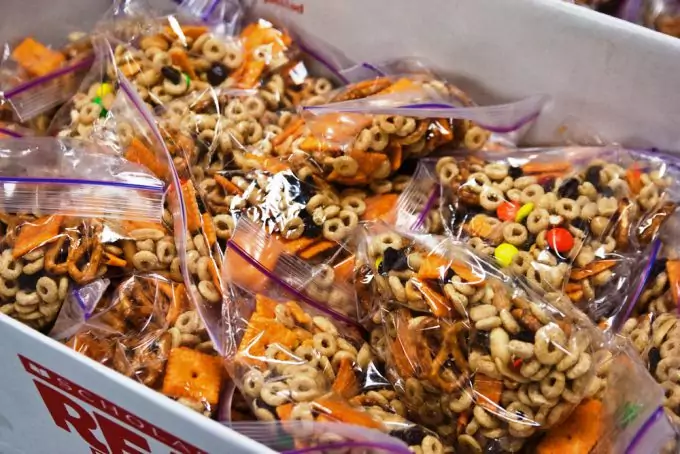
Good snacks should include granola bars, pretzels, chips and salsa, potato/corn chips, trail mix, fruit, and nuts. These are more likely to keep you energized and feeling full for a little bit longer before it’s time for the next meal of the day. Minimize the spilling of these snacks, especially if you’re snacking while hiking, as they can attract animals that you don’t really want on your tail, such as bears.
Drinks
Drinks are essential to maintain your body’s hydration levels, and water is the safest bet to go with if you’re struggling to figure out what to bring. But if you have kids with you, they’re going to want more than just water. Bringing some juice boxes can quell their need for something suit and will provide them with some amount of energy throughout the day.
Pre-packaged sachets of coffee, hot chocolate, and tea are also easy to bring with you and are a great energy booster at the start of the day. Be wary that coffee does tend to dehydrate the body, so only drink it in moderation.

Image credit: ourtravelingtribe.com
Sports drinks can also serve to keep your electrolyte levels up when you’re out doing strenuous work. Being dehydrated without the means to call for help can lead some serious medical issues. If you don’t have the room for sports drinks, there are powdered sachets that can be added to your water to provide you with the electrolytes that you need, and they’re easy to carry on your person. Carbonated drinks should be saved for the end of the day as a special treat, and the cans should be disposed of properly to prevent animals and insects from infesting your campsite.
Seasoning
There’s no reason to continue eating bland and flavorless food when you can bring seasonings with you. They’re easy to keep in ziplock bags, won’t go bad, and you only ever need a small amount each time, so they can be stretched out throughout the duration of your camping trip. Simple spices such as salt and pepper are a must, while you can also include other spices such as red chili flakes, thyme, rosemary, and low sodium soy sauce. Just a little added to any meal can make all the difference in the world to your taste buds.
Departure day: Time to go home
Typically, breakfast is the last meal that people have during their camping trip, and it pays to go light in this respect. When you’re packing up all your belongings, the last thing you need to do is make a grand meal that will not only take a lot of time to make, but will also take a lot of time to clean up as well. Stick with light choices that require little preparation, but will make you and your fellow campers full and contented by the time everyone is ready to go.
Keeping your meals in check
Planning requires that you don’t overindulge, or you could end up with less food towards the end of the trip than what you bargained for. After your meal choices have been decided, review them each and every day to make sure that you’re accounting for what’s left over.
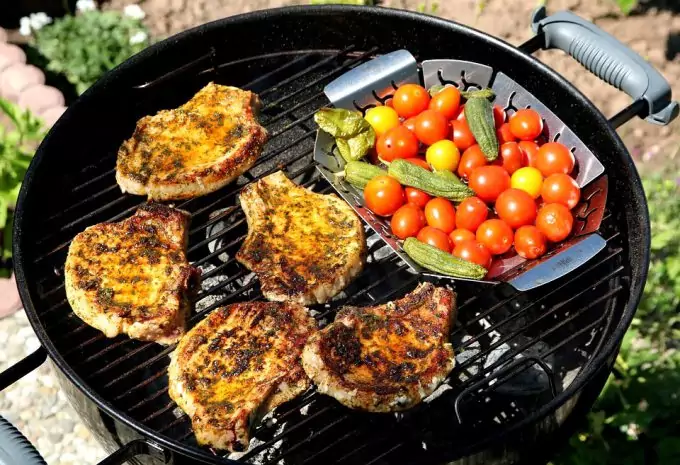
Knowing what you have left can help you to adjust the meal options when something unexpected crops up. For example, if one member of your camping crew suddenly has intestinal distress, they’re going to need to be kept hydrated, and that may mean allocating more fluids to them than the rest of the group. You can’t plan ahead for all circumstances, but keeping them in mind will help you to prepare your meals much better.
You should plan similar meals for each day first – do all breakfasts, then lunches, et cetera – as this will help you to figure out the ingredients that you’ll need for each meal. Having the meals you want to make won’t help you figure out how much you need to bring, and you may end up packing too much food that you don’t really need. Being flexible also helps, as you can use leftovers from dinners to make sandwiches for breakfast or lunch the next day.
Condiments and beverage quantities should also be allocated and listed in order to ensure you have enough, and always add a little extra to the list just in case. You may go through your water supply a lot faster than you intend. However, if you do bring a few water purification options with you, then you’ll be in a better position to stay hydrated.
Foods you should include in your list
When it comes to preparing a camping food list that you should bring with you, there are some essential foods that are not only versatile, but are also easy to carry and will help you to maintain your nutrition, especially when you’re away from the convenience of your fridge.
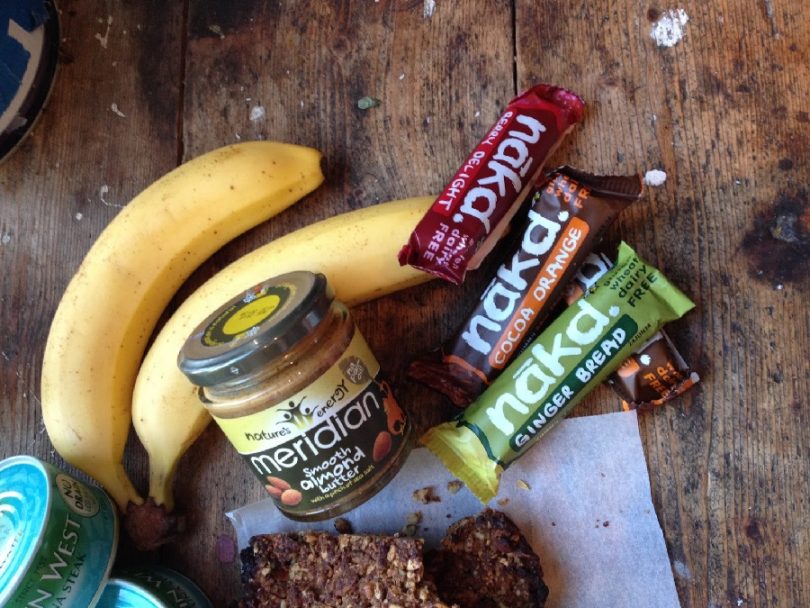
Space is limited, so it pays to know which foods you’re going to get the most benefits from.
- Bananas: fruit is always a great addition to add to any list of camping food, but bananas should be at the top of your list ahead of apples and oranges. They are high in potassium as well as other nutrients, are easy to transport, and can be very filling. They can be used as a snack throughout the day or be incorporated into your main meals, if you like, including dessert. They’re very flexible when it comes to planning your meals.
- Bread: sandwiches, French toast, hotdog rolls and hamburger buns, bread has so many uses in a lot of meals that it’s difficult to eat without it in some shape or form. They are extremely shelf-stable and will keep for a long time as long as they’re not exposed to the elements. Bread can be substituted for pre-baked biscuits as well, adding a different flavor to your meals that will leave you feeling just as full.
- Peanut butter and jelly: when push comes to shove, PBJ sandwiches are the fall back of any camping trip. It’s easy to make, provides you with some sugar as well as some protein to keep you going throughout your day. Or you can use the peanut butter with your pretzels as a snack, and your jelly on a piece of toast for breakfast. It’s all up to you how you use them, but they should definitely be included in your arsenal against hunger.
- Granola bars: these handy bars are filled with oatmeal, peanuts, and sometimes fruit, so you can have all of your vitamins and nutrients in one place. As well as for breakfast, they also serve as good snacks between meals, and can curb your sweet tooth with the variety of flavor options that they have in the market. Granola bars are also packed with fiber to keep you regular, which can be a problem for most when they’re camping out in the wild.
- Graham crackers, marshmallows and chocolate: the traditional ingredients for Smores are always a given, and can add some fun to your evenings after you’re winding down from a hard day. To be without them would be like not having turkey for Thanksgiving.
Whatever you include in your camping food list is really up to you, taking into account any special dietary needs there may be, as well as food allergies. Preparing ahead of time ensures that you have covered all of your bases to ensure everyone is receiving the nutrition that they need while still enjoying themselves.

Image credit: mariposabaking.com
It can be difficult to be without the modern conveniences of our cupboards and fridges so that we may indulge whatever we want, but it’s best to remember that your camping trip will end eventually, so it’s best to enjoy your time out with nature as much as you can.
[the_ad_placement id=”in-text-3-type-r”]An important tip to remember is that you should always carry your garbage with you when you leave your camping site. It should be as if you were never there at all, not only for the benefit of whoever comes to the site after you, but to also prevent the gathering of animals in the area, such as bears and raccoons.



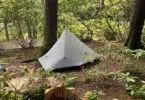
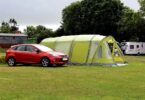
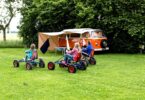
I have gone four times camping, and I can’t stress this enough: eat what you typically eat. If you change your eating routine, it can truly disturb your digestion and can destroy your weekend. I more often than not eat an enormous amount of nuts, seeds, jerky, granola bars, dried fruit. If you can get a grill/stove and bring some food that you can cook, that would be ideal.
Camping is fan when you get to do things that you usually do. This includes your cooking; you can engage campfire recipes, but you should not completely interfere with your usual cooking.
I like to make a big batch of trail mix with lots of nuts. They are rich in fat, so they’re calorie dense and are lighter to pack, I’m not forced to cook or preserve anything, and I could conveniently make small rations to dispense my calories uniformly during the day.
I might also bring powders that I can mix in water and drink quickly..
Hi Peter!
Trail mixes are always good to bring along a hiking/camping trip and portioning them is a good idea as well. The best about home made trail mixes is that you can put in just what you want. Some store bought mixes would include nuts that some are allergic too, or dates that not everybody likes.
Samuel